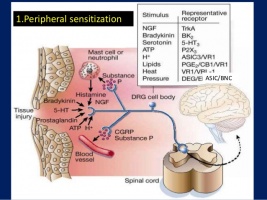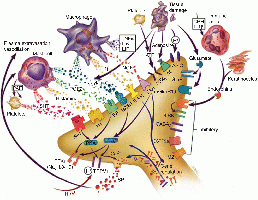Peripheral Sensitisation: Difference between revisions
No edit summary |
Bruno Serra (talk | contribs) (Added definitions and a reference link for primary and secondary hyperalgesia.) |
||
| Line 6: | Line 6: | ||
== Physiological Process of Peripheral Sensitization == | == Physiological Process of Peripheral Sensitization == | ||
Following an injury or cell damage, two main things can occur. '''Primary hyperalgesia''' and '''secondary hyperalgesia'''. Secondary hyperalgesia is indicative of central sensitization. <ref>Pezet S, McMahon SB. Neurotrophins: mediators and modulators of pain. Annu. Rev. Neurosci.. 2006 Jul 21;29:507-38..</ref> | Following an injury or cell damage, two main things can occur. '''Primary hyperalgesia''' and '''secondary hyperalgesia'''. Primary hyperalgesia occurs in areas of tissue damage, whereas secondary hyperalgesia occurs in healthy skin next to or further away from the location of injury. Primary hyperalgesia can be identified by heightened sensitivity to heat and mechanical stimulation in the area of damage. Secondary hyperalgesia, on the other hand, is often associated with increased reactions to mechanical but not thermal stimuli.<ref>Hsieh MT, Donaldson LF, Lumb BM. [https://www.ncbi.nlm.nih.gov/pmc/articles/PMC4535358/ Differential contributions of A- and C-nociceptors to primary and secondary inflammatory hypersensitivity in the rat]. Pain. 2015 Jun;156(6):1074-1083. doi: 10.1097/j.pain.0000000000000151. PMID: 25760474; PMCID: PMC4535358.</ref> Secondary hyperalgesia is indicative of central sensitization. <ref>Pezet S, McMahon SB. Neurotrophins: mediators and modulators of pain. Annu. Rev. Neurosci.. 2006 Jul 21;29:507-38..</ref> | ||
Peripheral sensitization is an increased sensitivity to an afferent nerve stimulus. This occurs after there has been an injury or cell damage to the area, and produces a flare response due to nociceptors producing lots of neuropeptides, which results in an increased sensitivity to heat and touch stimuli which is referred to as primary hyperalgesia or primary allodynia if the stimulus was not a painful one prior to the injury. For example, a gentle stroke to the skin which before the injury is not painful but after is interpreted as pain.<ref name="Bolay">Bolay H, Moskowitz MA. Mechanisms of pain modulation in chronic syndromes. Neurology. 2002 Sep 10;59(5 suppl 2):S2-7.</ref><ref>Graven-Nielsen T, Arendt-Nielsen L. Peripheral and central sensitization in musculoskeletal pain disorders: an experimental approach. Current rheumatology reports. 2002 Aug 1;4(4):313-21.</ref> | Peripheral sensitization is an increased sensitivity to an afferent nerve stimulus. This occurs after there has been an injury or cell damage to the area, and produces a flare response due to nociceptors producing lots of neuropeptides, which results in an increased sensitivity to heat and touch stimuli which is referred to as primary hyperalgesia or primary allodynia if the stimulus was not a painful one prior to the injury. For example, a gentle stroke to the skin which before the injury is not painful but after is interpreted as pain.<ref name="Bolay">Bolay H, Moskowitz MA. Mechanisms of pain modulation in chronic syndromes. Neurology. 2002 Sep 10;59(5 suppl 2):S2-7.</ref><ref>Graven-Nielsen T, Arendt-Nielsen L. Peripheral and central sensitization in musculoskeletal pain disorders: an experimental approach. Current rheumatology reports. 2002 Aug 1;4(4):313-21.</ref> | ||
Revision as of 15:35, 26 July 2023
Original Editor - Michelle Lee
Top Contributors - Michelle Lee, Shaimaa Eldib, Melissa Coetsee, Admin, Jo Etherton, Bruno Serra, Khloud Shreif and Mathius Kassagga
Physiological Process of Peripheral Sensitization[edit | edit source]
Following an injury or cell damage, two main things can occur. Primary hyperalgesia and secondary hyperalgesia. Primary hyperalgesia occurs in areas of tissue damage, whereas secondary hyperalgesia occurs in healthy skin next to or further away from the location of injury. Primary hyperalgesia can be identified by heightened sensitivity to heat and mechanical stimulation in the area of damage. Secondary hyperalgesia, on the other hand, is often associated with increased reactions to mechanical but not thermal stimuli.[1] Secondary hyperalgesia is indicative of central sensitization. [2]
Peripheral sensitization is an increased sensitivity to an afferent nerve stimulus. This occurs after there has been an injury or cell damage to the area, and produces a flare response due to nociceptors producing lots of neuropeptides, which results in an increased sensitivity to heat and touch stimuli which is referred to as primary hyperalgesia or primary allodynia if the stimulus was not a painful one prior to the injury. For example, a gentle stroke to the skin which before the injury is not painful but after is interpreted as pain.[3][4]
Up-regulation of existing receptors:[edit | edit source]
This can occur as a result of inflammation. Chemical mediators of inflammation such as histamine, bradykinin, acids, and serotonin are released and can either stimulate them making them depolarize or sensitize them (bringing the membrane potential closer to the depolarization threshold). This influences the threshold is known as peripheral sensitization. This occurs when the chemical mediators stimulate the receptors on the nociceptive terminals. This then influences the protein enzyme cascade which then up-regulates the ion channels and sodium-specific nociceptive channels. This then results in them becoming more sensitive to the chemical mediators and causes an influx of ions. This influx of ions then cause the stimulation of action potentials which then in turn produces 'pain.' [3][5][6]
In summary, the nociceptor terminals become more sensitive to the same quantity of the chemical mediators.
Up-regulation of new receptors:[edit | edit source]
The cell body which is located in the dorsal root ganglia sensory nerves produce protein channels and transmits signals to the nociceptive terminals. When there is inflammation present as described above we also get the Nerve Growth Factor produced which transmits up to the cell body in the dorsal root ganglia. This then also stimulates the production of ions, which as described above, stimulates the receptors on the nociceptive terminals. Now the nociceptive terminals have a greater quantity of the 'chemical mediator' stimulating the sensation of pain more frequently.
The difference between central and peripheral sensitization can be identified quite easily, as peripheral sensitization becomes heat-sensitive whereas central sensitization does not. Lorimer Moseley explains this in more detail in the video below.[3][7]
What does this Mean?[edit | edit source]
Hypersensitivity following an injury is an important self-preservation mechanism, which allows the injured tissue to heal and to continuously warn/remind the brain to avoid further injury to this area. When this hypersensitivity becomes prolonged and develops into peripheral sensitization be it through either; increased sensitivity to the chemical modulators or a decreased threshold to the stimulus provides the body with no benefit. peripheral sensitization is important to identify in patients as this can have an impact on treatment and their experience of pain as assessment through touch or movement may stimulate an unexpected level of pain. Peripheral sensitization manifests its symptoms similarly to central sensitization. [10]
References[edit | edit source]
- ↑ Hsieh MT, Donaldson LF, Lumb BM. Differential contributions of A- and C-nociceptors to primary and secondary inflammatory hypersensitivity in the rat. Pain. 2015 Jun;156(6):1074-1083. doi: 10.1097/j.pain.0000000000000151. PMID: 25760474; PMCID: PMC4535358.
- ↑ Pezet S, McMahon SB. Neurotrophins: mediators and modulators of pain. Annu. Rev. Neurosci.. 2006 Jul 21;29:507-38..
- ↑ 3.0 3.1 3.2 Bolay H, Moskowitz MA. Mechanisms of pain modulation in chronic syndromes. Neurology. 2002 Sep 10;59(5 suppl 2):S2-7.
- ↑ Graven-Nielsen T, Arendt-Nielsen L. Peripheral and central sensitization in musculoskeletal pain disorders: an experimental approach. Current rheumatology reports. 2002 Aug 1;4(4):313-21.
- ↑ Staud R, Smitherman ML. Peripheral and central sensitization in fibromyalgia: pathogenetic role. Current pain and headache reports. 2002 Aug 1;6(4):259-66.
- ↑ Van Griensven H, Strong J, Unruh A. Pain: a textbook for health professionals. Churchill Livingstone; 2013 Nov 1.
- ↑ Mizumura KA. Peripheral mechanism of hyperalgesia-sensitization of nociceptors. Nagoya journal of medical science. 1997 Nov 1;60:69-88.
- ↑ Laree Draper. Lorimer Moseley Pain DVD Sensitivity to Heat, Peripheral Sensitization. Available from: http://www.youtube.com/watch?v=VmQT5NgsUdc[last accessed 20/8/2021]
- ↑ Dr Matt & Dr Mike. Chronic Pain and Sensitisation. Available from: http://www.youtube.com/watch?v=rxl6c8UwmKs[last accessed 20/8/2021]
- ↑ Van Griensven H, Strong J, Unruh A. Pain: a textbook for health professionals. Churchill Livingstone; 2013 Nov 1.








